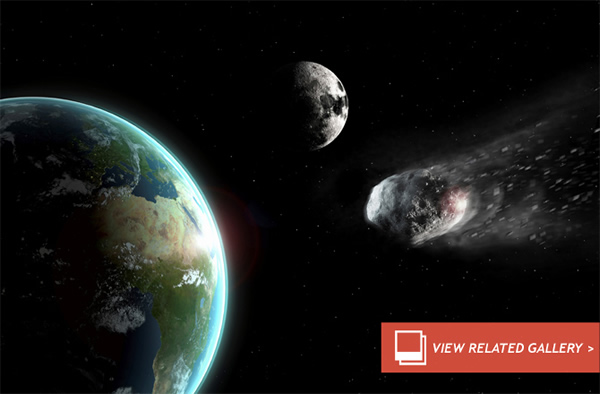Has Earth Splattered Life All Over the Solar System?
Lithopanspermia: put that word in your “cool new space words” dictionary. But what does it mean? It means spreading life, preserved within chunks of Earth rock, after being hit by huge meteorite impacts. It also means that terrestrial life could be the proverbial space invaders of science fiction, and not vice versa.
In new research, scientists have investigated the probability of chunks of Earth’s crust being blasted from our planet’s surface by asteroid impacts over the past 3.5 billion years, potentially spreading the seed of life to other planets in our solar system.
As can probably be guessed from the name, lithopanspermia is a modification of the “panspermia” mechanism — the hypothesis that life can hop from one planetary body to the next, helped along by cataclysmic impact events. Hardy bacteria that evolved on Planet A are ejected from the surface trapped inside a chunk of rock. Should they be sufficiently shielded and have a certain flair for deep space living, they may survive (or even not survive — as the necropanspermia hypothesis posits) and be deposited on Planet B via meteorite, potentially spawning life there.
The best thing is that we know the transportation mechanism for panspermia exists — rocks from Mars, for example, have been discovered as meteorites on Earth — so it’s not a huge stretch of the imagination to think that biological matter may hitch a ride too. And the more we find out about the extreme environment-loving microbes on Earth (aptly called extremophiles), the more the panspermia hypothesis seems to make sense.
Naturally, this idea has sparked intense philosophical discussions amongst astrobiologists. What if extraterrestrial life came from space and spawned life on Earth via meteorite impact billions of years ago? And now, the reverse is being discussed: what if life on Earth has been FedEx’d throughout the solar system, perhaps spawning life on Mars or even Europa?
In new research published in the journal Astrobiology (doi:10.1089/ast.2013.1028), researchers carried out a simulation of asteroid impacts on Earth to see how many bits of terrestrial material ended up on Mercury, Venus, Mars and as far afield as the gas giants Jupiter and Saturn. Of particular interest the researchers took a stab at calculating the amount of Earth debris that may have made it onto the surfaces of the Jovian moons Europa, Io and Callisto and Saturn’s fascinating moon Titan.
“We found that, in addition to frequent transfer of material among the terrestrial planets, transfer of material from Earth and Mars to the moons of Jupiter and Saturn is also possible, but rare,” write the researchers, headed by astrobiology graduate student Rachel Worth, of Penn State University.
“We find that rock capable of carrying life has likely transferred from both Earth and Mars to all of the terrestrial planets in the solar system and Jupiter,” Worth told BBC News.
This is a fascinating field of study, one that will likely spur even more heated debates as to the origin of life and whether it is ubiquitous throughout the galaxy.
“Any missions to search for life on Titan or the moons of Jupiter will have to consider whether biological material is of independent origin, or another branch in Earth’s family tree,” Worth added.
In their simulation, the researchers revealed that around 26,000,000 chunks of Earth material, over 3 meters wide, has likely made it to Venus. Three meters is the minimum diameter of rock, according to the researchers, that would have given enough shielding to the biology contained within against the space radiation environment to survive the interplanetary voyage. 730,000 pieces would have made it to Mercury, 360,000 to Mars, 83,000 to Jupiter and 14,000 to Saturn. Also, they found that 10 Earth meteorites would have impacted Io, 6 would have landed on Europa, 4 on Titan and 1 on Callisto.
There’s no way of knowing if these Earth rocks contained bacteria, or whether panspermia is actually a means to transport life through interplanetary space. But it is interesting to find out, once you calculate the frequency of planetary impacts and the debris they produce, just how much material is shared by the planets in our solar system.
One event Worth points out is the Chicxulub impact in Mexico that occurred 66 million years ago and is thought to have triggered the extinction of the dinosaurs — 70 billion kilograms of rock is thought to have been blasted from Earth’s gravitational pull, 20,000 kilograms of which could have reached as far as Europa. It's interesting to think that there might be dinosaur DNA embedded in Europa ice.
Mars is known to have been a far more habitable place millions of years ago, so could asteroid impacts on Earth and Mars have initiated a “life-sharing program?” And of the small number of Earth chunks that made it as far as Europa, did any contain our biology, potentially crashing into the icy surface and finding an evolutionary niche deep within the moon’s subsurface ocean?
The only way to find out is to physically explore these fascinating worlds, potentially piecing together the life-giving potential, not only of their habitability status, but also if they’re playing host to organisms with a very Earth Brand™ flavor.(Dec 11, 2013 03:16 PM ET // by Ian O'Neill)












